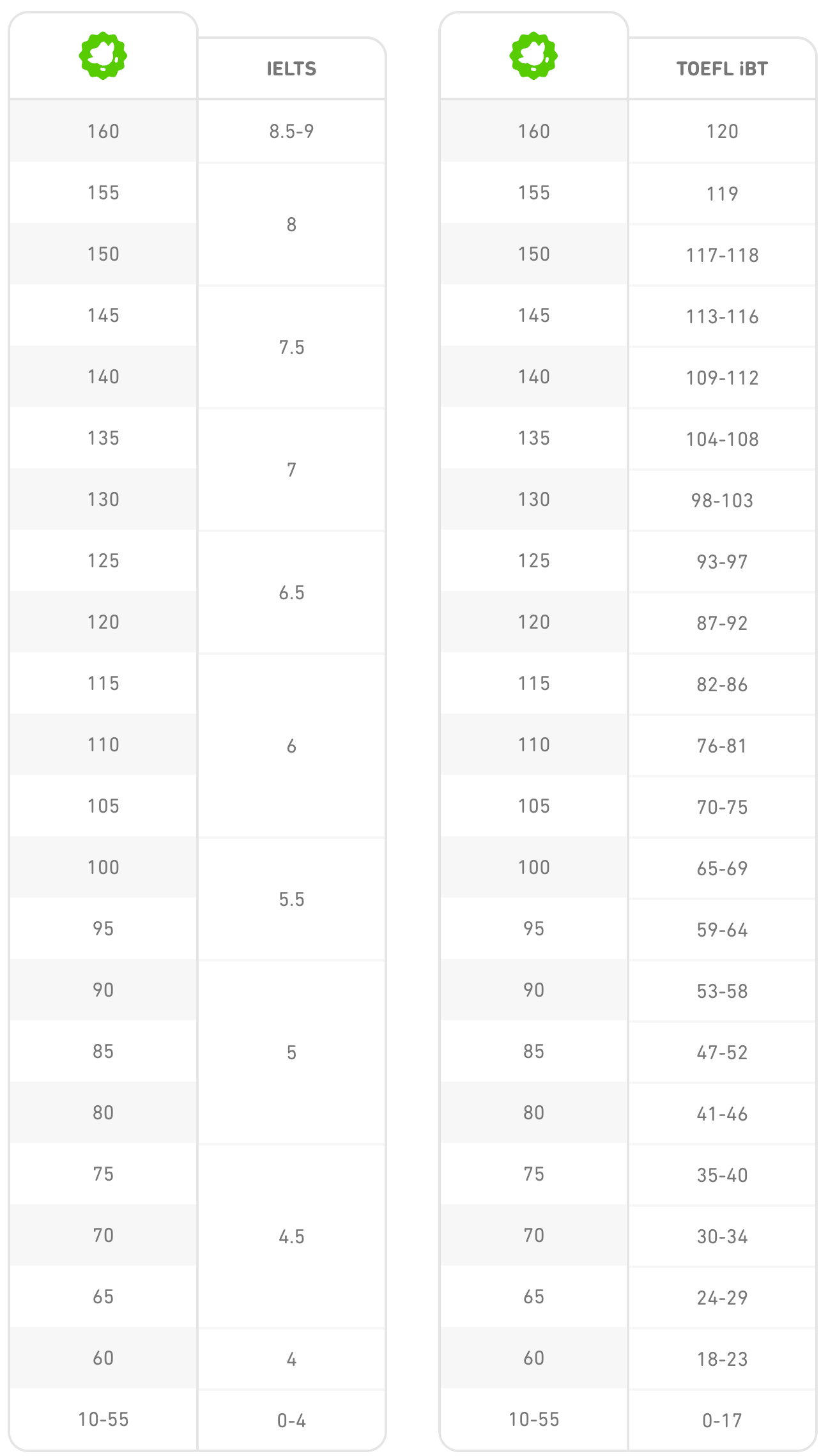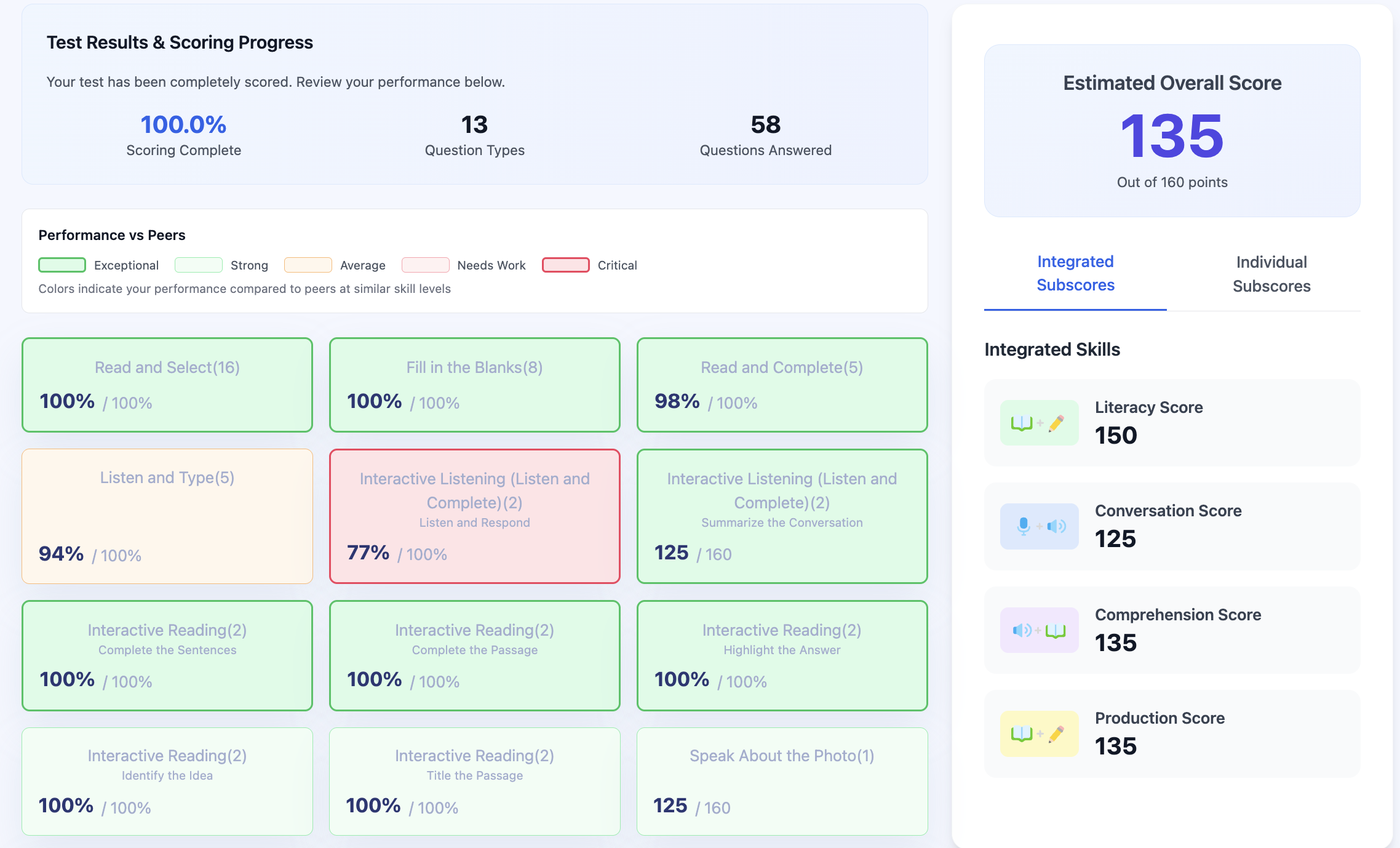Explained: Duolingo English Test Scores
The Duolingo English Test's scoring is powered by an advanced system that combines language assessment expertise with AI. This ensures that DET scores are fair, reliable, and consistent with other English proficiency tests.
In this article, we're going to cover everything you need to do about DET scores. Let's jump in!

Table of Contents
- How is the Duolingo English Test Scored?
- The Duolingo English Test Subscores
- How are reading and listening scored on the DET?
- How are writing and speaking scored on the DET?
- How Duolingo ensures a fair test
- What is a good score on the Duolingo English Test?
- How do Duolingo scores compare to TOEFL and IELTS?
- How long does it take to get your score?
- Can you see your score on each question?
- How to get an estimated score
- How to improve your score

How is the Duolingo English Test Scored?
DET scores are between 0 and 160. When you take the test, you will be given 9 scores: 8 subscores and 1 overall score.
Here is what your score certificate will look like:

The Duolingo English Test Subscores
There are 2 kinds of subscores on the DET. The first are the standard components of Reading, Writing, Listening, and Speaking.

You also have the integrated subscores, each of which is an average of 2 standard subscores.

Here is how each integrated subscore is calculated:
- Literacy = Reading and Writing
- Comprehension = Reading and Listening
- Conversation = Speaking and Listening
- Production = Writing and Speaking
Here is the official diagram provided by Duolingo to help explain as well:

Duolingo explains that they use these categories because, “While reading, writing, speaking, and listening are important language components, research shows that combined skills can better represent how language is used in real life. Effective language use requires people to employ multiple skills simultaneously.” (Source)
Originally, they only had the integrated subscores. After feedback from universities, they added the standard subscores so that DET results could more easily be compared to the results from other tests like TOEFL and IELTS.
How are reading and listening scored on the DET?
Most of the reading and listening questions have one correct answer or a small number of correct answers. For some questions, you can receive partial credit. Here is a list of the questions for which partial credit is given:
- Read and Complete: You get credit for each incomplete word you get completely correct in a passage. You must get all the letters correct for an incomplete word to get credit for that word.
- Listen and Type: Each response can score between 0 and 1. The closer your answer is to the correct answer, the closer to 1 your score will be. A perfect response gets the full 1 point.
- Interactive Reading: Highlight the Answer responses are also graded on a 0 to 1 scale, with a perfect answer receiving 1. For Complete the Sentences (the first question), you get a point for each missing word you correctly identify.
Reading and listening questions are also adaptive. This means that the difficulty of the questions you see on the test adjusts to your level. If you get a question correct, the next questions will be more difficult and vice-versa. This means that you won't waste time answering questions that are too difficult or too easy for you.
How are writing and speaking scored on the DET?
There is not one correct answer to writing and speaking questions, so to score these kinds of questions, the DET uses sophisticated AI models trained on thousands of responses scored by human experts. The AI models' scores are continuously monitored by assessment experts to ensure that the scores they produce are accurate.
There are 6 scoring criteria that Duolingo considers when evaluating writing and speaking responses:
- Content: Does the test-taker answer the prompt that they were given? Do they effectively develop their ideas?
- Discourse coherence: How clearly does the test-taker express their ideas? Do the ideas in a response work together logically?
- Grammar: Does the test-taker avoid grammatical mistakes? Do they use complex grammar structures?
- Lexis (Vocabulary): Does the test-taker use words correctly? Do they use a diversity of precise vocabulary?
- Fluency (Speaking questions only): Does the test-taker speak at a natural pace without unnatural pauses? Do they rely too much on filler words?
- Pronunciation (Speaking questions only): Does the test-taker pronounce individual sounds and words correctly? Do they place emphasis on the right parts of sentences?
Arno's instant feedback will help you improve on all of these scoring criteria. After you submit your response, you will get an instant score and detailed feedback on the strengths and weaknesses of your response:

Arno's Grammar Tutor will also point out your grammar mistakes and allow you fix them, so that you can learn from them:

Arno will also rewrite your response so that you can see how to improve your phrasing and more advanced vocabulary that you could have used:

You can get feedback like this on 5 of your responses for free. In addition, every new Arno user gets a full, free mock test with subscores and feedback on every one of your responses. To take advantage of all that Arno has to offer, just click below to create your free account!

How Duolingo ensures a fair test
The DET has multiple levels of checks to ensure that the test is fair. Any responses that aren't in English, unoriginal, or off-topic are flagged. The test questions themselves are also continuously monitored to make sure that no group of test-takers is unfairly disadvantaged. These fairness checks look at aspects like first language, gender, and country. Duolingo also ensures that results are reliable, meaning that even if two students get different questions, their scores are still comparable.
In short, the DET gives you an accurate measure of your English level, just more conveniently and at a much lower cost compared to other tests.
What is a good score on the Duolingo English Test?
The definition of a “good score” really depends on what school or program you are applying to. Some schools require higher scores than others. You can see all the places that accept the DET here to learn about the required scores at different schools.
In general, many schools require scores around 120. So, if you don’t know where you will be applying yet, 120 is a good score to aim for.
120 is a highly attainable score. In 2024-2025, the average overall score of all test takers was 110.59. 25% of test-takers scored below 100 and 25% scored above 125. In other words, half of all of test-takers scored between 100 and 125. The numbers are similar for the subscores as well. So, to score 120 you need to be just somewhat above average!
How do Duolingo scores compare to TOEFL and IELTS?
Here is a chart provided by Duolingo that shows how your DET score corresponds to scores on TOEFL and IELTS:

The average score of 110 on the DET corresponds to 76-81 on TOEFL and a 6 on IELTS.
How long does it take to get your score?
One of the great things about the DET is that you will get your scores within 2 days of taking the test! You can also share your score with as many places as you would like for no extra charge.
Can you see your score on each question?
Unfortunately, no. You can only see each subscore. That's why we built Arno's mock test 😁 For reading and listening questions, we show you which questions you got orrect and incorrect, and for writing and listening questions, we give you detailed feedback on your structure, grammar, and vocabulary.

We also have mini mock tests that you allow you focus on specific areas!

Just click here to create your free Arno account and claim your free mock test!
How to improve your score
If you have the money, we recommend that you take the test one time to get an accurate overall score and, more importantly, accurate subscores. If you need to raise your score, then you can focus on raising your lowest subscore. If you don’t want to pay to take the test twice, then you can also take a full mock test in Arno.
Once you have identified your weak areas, you can then practice the relevant question types in Arno. We give you unlimited practice questions for every question type for free! Just click here to create your account.